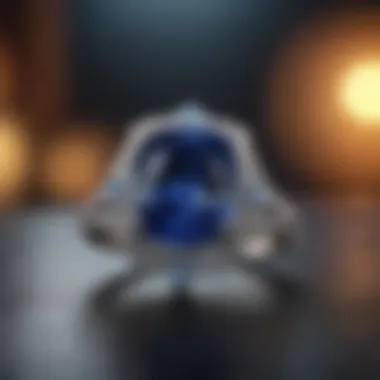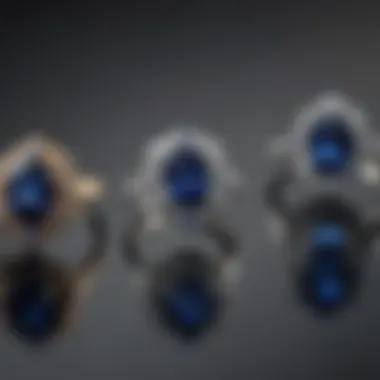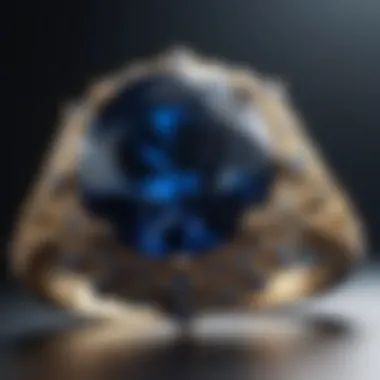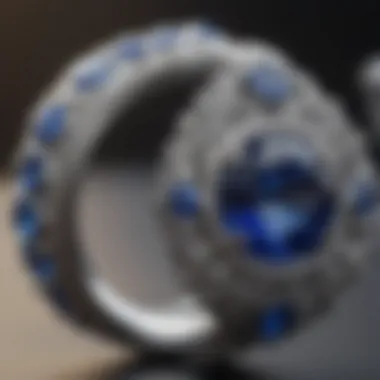Understanding 3 Carat Sapphire Ring Pricing


Intro
Gemstone Overview
Definition and Origins
Sapphires are a type of corundum, a mineral composed of aluminum oxide. While many associate sapphire with the classic blue hue, they can also occur in a variety of colors, known as fancy sapphires. Sapphires are found all over the world, with notable sources including Sri Lanka, Myanmar, and Madagascar. Each region contributes unique traits to the stones, influencing desirability and, consequently, price.
Historical Significance
The history of sapphires is long and storied. Ancient cultures valued these gemstones for their beauty and believed they offered protection and wisdom. In many traditions, sapphires were thought to reflect the heavens’ favor. Royalty and clergy favored sapphires, embedding them in crowns and sacred artifacts. This historical significance continues to affect current market valuations, as many buyers seek sapphires associated with heritage or rarity.
Gemstone Properties
Hardness and Durability
On the Mohs scale of mineral hardness, sapphires score a 9, making them one of the hardest natural materials. This durability allows sapphires to maintain their beauty over time. Their toughness is an essential selling point, particularly for jewelry such as rings, which are subject to daily wear. Buyers should analyze how a sapphire's durability can affect its long-term value.
Color and Clarity
The color of a sapphire is a primary determining factor in its pricing. Rich, vibrant hues command higher prices, especially deep blue sapphires. Color variations, such as yellow or pink sapphires, may also appeal to various buyers. Another critical aspect is clarity. Fewer inclusions typically mean a higher value, although some inclusions can be characteristic of a stone's origin and add uniqueness.
"When purchasing a sapphire, both color and clarity must be carefully evaluated to ensure value and satisfaction."
In summary, the pricing of 3 carat sapphire rings hinges on multifaceted factors including gemstone properties and historical significance. By understanding these aspects, buyers are better positioned to make informed decisions in the always-evolving sapphire market.
Foreword to Sapphire Pricing
The pricing of sapphire rings, especially those weighing around three carats, is a multifaceted topic that deserves careful examination. Understanding the nuances of sapphire pricing can greatly impact both consumers and collectors. The decision to purchase a sapphire ring involves several considerations, including quality, market trends, and individual preferences, all of which can ultimately affect the price.
One important factor is the quality of the sapphire itself. Not all sapphires are created equal. Differences in color saturation, clarity, and cut can lead to substantial price variations. Buyers must understand what defines a high-quality sapphire.
Another notable element is the clarity and cut of the stone. Clarity can refer to the presence of inclusions or blemishes. A stone that is clear and well-cut will generally command a higher price. Additionally, carat weight plays a significant role in pricing. A three-carat sapphire often represents a striking visual appeal, and its price will reflect its desirability.
Furthermore, market demand cannot be ignored. Trends in jewelry fashions change, and so does the demand for specific types of sapphires. Cultural influences and investment strategies also drive the market, as collectors look for stones with historical or aesthetic significance.
All of these factors combine to create a complex pricing structure for sapphire rings. Potential buyers should educate themselves about these elements before making a purchase. This knowledge can enhance their confidence in navigating the sapphire market, allowing them to appreciate the value of their investment.
"Education about sapphire pricing is key for anyone looking to make a meaningful purchase. It empowers consumers and collectors alike."
In summary, understanding sapphire pricing not only helps consumers make informed decisions but also allows them to appreciate the beauty and rarity of these exquisite stones. The importance of examining how various factors interact is crucial to grasping the value of a three-carat sapphire ring.
Factors Influencing Sapphire Prices
Understanding the pricing of sapphires requires dissecting several influential elements. The value of a sapphire does not solely rest on its weight. Instead, it is the collective assessment of several quality parameters and market dynamics that determines price. Each sapphire is unique, and investors or buyers should consider these determining factors carefully when making a purchase.
Quality of the Sapphire
Color
Color is perhaps the most crucial factor in determining a sapphire's quality and value. A sapphire's hue can vary dramatically, from deep blue to light sky blue, to even shades of pink and yellow. The most sought-after sapphires showcase a rich, vibrant blue with no color zoning. The depth of color significantly contributes to the stone's overall appeal and market demand. Well-colored sapphires can command much higher prices due to their aesthetic desirability and rarity.
Clarity
Clarity refers to the presence of inclusions, or internal flaws, within a sapphire. A stone with minimal inclusions is deemed more valuable. Transparency, or the ability to see through the stone clearly, adds to its allure. Buyers should know that even small inclusions can affect the value. A sapphire with superior clarity not only enhances visual appeal but also tends to attract high prices.
Cut
The cut of the sapphire influences how light interacts with the stone, affecting its brilliance. A well-cut sapphire will display optimal sparkle and color. Different cuts, such as oval, round, or cushion, can alter the appearance of a stone and its value. A high-quality cut is typically associated with a higher price due to the skill required in its making and the visual impact it provides.


Carat Weight
Carat weight is a significant determinant of price. Generally, larger sapphires are rarer, making them more valuable. However, it is crucial to understand that carat weight does not always correlate directly with price per carat. Two sapphires of the same weight can have vastly different values based on their color, clarity, and cut.
Origin of the Sapphire
Sri Lankan Sapphires
Sri Lankan sapphires, specifically known for their vibrant blues, hold a prominent place in the sapphire market. The quality and beauty of these stones often make them a preferred choice for consumers and collectors. The rich heritage of Sri Lankan gem-cutting techniques also contributes to the reputation of these sapphires. However, their popularity can also lead to increased prices due to demand.
Burma Sapphires
Burma, or Myanmar, is famous for producing some of the highest quality sapphires, particularly those exhibiting a deep, velvety blue hue. Many enthusiasts consider these the best because of their unique coloring and transparency. However, the political climate around the sourcing of these stones can introduce ethical concerns, potentially affecting buyer decisions and market value.
Australian Sapphires
Australian sapphires often showcase a variety of colors, including beautiful dark blues and greens. Their affordability compared to others makes them a favorable option for mid-range buyers. However, they may not carry the same prestige or value as sapphires from Sri Lanka or Burma, which can influence pricing in the market.
Madagascan Sapphires
Madagascan sapphires are known for their unique and various hues. These sapphires have been emerging in recent years, captivating the market. While they usually offer good value, their lesser-known status may yield fluctuating prices as demand increases and competition among regions rises.
Market Demand and Trends
Current Market Trends
Current market trends play a significant role in sapphire pricing. If there's an increase in demand or a heightened interest in sapphire jewelry, prices may soar. Keeping up with these trends is essential for every buyer. Prices fluctuate as fashion changes, so understanding market dynamics can help buyers determine the right time to purchase.
Cultural Influences
Cultural preferences shape gemstone popularity. For instance, in Western cultures, blue sapphires are often associated with engagement rings, increasing demand in that sector. In contrast, other cultures may value different colors or uses, affecting their pricing. Understanding these influences can add depth to buyers' knowledge, helping them to make informed decisions.
Investment Considerations
In recent years, sapphires have attracted investment attention. Many perceive them as tangible assets, leading to an increase in demand and, subsequently, pricing fluctuations. An investor should consider the stone's quality and provenance when investing in sapphires. Strong market knowledge can result in good opportunities for growth in value.
Understanding Carat Weight
Understanding carat weight is crucial when evaluating the price of a 3 carat sapphire ring. Carat weight directly influences the overall cost, making it essential for buyers to comprehend this aspect fully. The perception of carat weight can also vary depending on factors such as size, shape, and the individual's expectations. Knowledge of carat weight not only helps in setting an appropriate budget but also in aligning quality with personal preference and investment goals.
Defining Carat Weight
Carat weight is a unit of measurement that reflects the weight of gemstones. One carat equals 200 milligrams. For sapphires, as with many gemstones, the carat weight contributes to the appearance and value. A 3 carat sapphire is significant and generally considered to have a more substantial presence than smaller stones. However, it is key to remember that carat weight is not the sole determinant of value. Two sapphires of the same carat weight may have vastly different prices due to factors such as color, clarity, and cut.
When discussing carat weight, buyers should also consider the size-to-weight ratio. For instance, a well-cut sapphire may appear larger than its carat weight suggests, making it a better option when visual impact is desired. Proper evaluation of carat weight helps establish realistic expectations regarding size and price.
Perceived Value of a Carat
The perceived value of a carat in sapphires is influenced by several factors. Consumers often associate higher carat weights with luxury and prominence. This perception can lead to a willingness to invest more in larger stones.
However, as mentioned earlier, the value of a sapphire depends on multiple aspects:
- Quality: The quality of the sapphire in terms of color, clarity, and cut can significantly affect its perceived value.
- Origin: Some origins, like Burmese or Sri Lankan sapphires, are highly coveted and can fetch higher prices even within the same weight classes.
- Market Trends: Evolving trends in consumer preferences can also alter perceptions of value. For instance, some buyers may prioritize larger stones, while others might seek more vibrant hues or specific characteristics.
Important Insight: Buyers should understand that while larger sapphires may generally command higher prices, it is not solely about size. Quality and unique attributes can just as easily impact value.
Price Ranges for Carat Sapphires
Understanding the price ranges for 3 carat sapphires is critical for making informed purchasing decisions. These prices can vary significantly based on multiple factors, including quality, origin, and market dynamics. Having a clear grasp of the ranges available can prevent buyers from overpaying and help identify genuine value when browsing different sources. It's essential to recognize that price is not solely determined by the carat weight. Evaluation of quality and market conditions is equally crucial.


Entry-Level Prices
Entry-level prices for 3 carat sapphires typically reflect stones that are of adequate quality but might lack the premium characteristics sought by more discerning buyers. Often, these gems are found in standard jewelry stores or online retailers specializing in more affordable options. The entry-level prices usually start around $1,500 to $3,000. Factors here may include sapphires with lighter shades or noticeable inclusions.
Buyers looking at entry-level ranges should focus on the basics:
- Assess the hue; lighter shades may reduce value.
- Check for clarity; some visible inclusions are acceptable.
- Evaluate the cut, as a standard cut can impact overall brilliance.
Mid-Range Prices
Mid-range prices for 3 carat sapphires are often between $3,000 to $7,000. These stones typically possess better color saturation and clarity compared to entry-level options. Additionally, the cut quality tends to be more refined. This range often includes sapphires with vivid blue hues and fewer visible inclusions. The mid-range offers a balance of quality and pricing, ideal for those seeking a beautiful piece without entering the luxury market. In this range, buyers should:
- Look for deep, intense colors that meet personal preferences.
- Ensure clarity is at least eye-clean unless the gem's origin compensates for such flaws.
- Inquire about the cut and its precision, as the shape can enhance overall appearance.
High-End Prices
High-end prices for 3 carat sapphires can start around $7,000 and can soar upwards to $15,000 and beyond, depending on the qualities of the gem. Stones in this category often exhibit exceptional color, clarity, and craftsmanship in their settings. Many of these sapphires are sourced from renowned locations like Kashmir or Burma, known for producing some of the finest stones globally. In high-end examples, buyers encounter:
- Rich, royal blue hues that are highly sought after.
- Superior clarity, typically eye-clean or with invisible inclusions.
- Exquisite cuts that maximize brilliance and sparkle.
Investing in high-end sapphires often requires consulting reputable jewelers or auction houses, where certification and provenance play an essential role in determining authenticity and value.
High-end sapphires offer a combination of beauty and investment potential, making them desirable both for personal adornment and as long-term assets.
Comparing Different Retail Channels
Online Retailers
Buying a 3 carat sapphire ring from online retailers is increasingly popular. These platforms often have extensive catalogs and competitive pricing. One advantage of online shopping is the ability to access a broader selection from various sellers worldwide, which can provide better deals. However, this convenience comes with its own set of challenges.
When purchasing online, ensure that the retailer has detailed descriptions and photographs of the gems. One may consider ratings and reviews to gauge the reliability of the seller. Nevertheless, the lack of physical inspection might leave some anxious about the quality and authenticity of the stone.
Key points to consider when choosing online retailers:
- Check for certain guarantees, such as satisfaction policies and return options.
- Look for websites that provide gemstone certification details.
- Be aware of shipping and handling fees, as they can affect the final price significantly.
Brick-and-Mortar Jewelry Stores
Physical stores have traditionally been the go-to option for buying sapphire rings. Shopping at a local jewelry shop allows customers to see and touch the rings before buying. This tactile experience can build confidence in the purchase. Furthermore, these stores often have knowledgeable staff that can provide personalized assistance and answer specific questions regarding the stone quality.
However, brick-and-mortar shops might not always offer the best deals. Prices can be higher due to overhead costs. It's also worth noting that the selection may be limited compared to what an online retailer can provide.
Considerations for buying in-store:
- Inspect the stone: Look for imperfections and check the overall craftsmanship.
- Ask about return policies and warranties.
- Don’t hesitate to negotiate on price, as there might be room for discussion.
Auction Houses
Auction houses present a different avenue for acquiring sapphire rings. These events allow buyers to bid on exclusive pieces, sometimes offering unique sapphires that are hard to find in retail settings. While prices can vary immensely, auction houses often attract high-quality gemstones. This option can be both thrilling and risky, as competitive bidding could lead to paying more than anticipated.
Before participating in an auction, it is crucial to conduct research on the items being sold. Buyers should be aware of the fees added to the final bid price, which can significantly increase the total cost. Additionally, understanding how auctions operate will help in making effective bids.
Things to keep in mind with auction houses:
- Familiarize yourself with specific bidding procedures and rules.
- Consider pre-auction estimates to understand fair pricing.
- Participate in preview events to evaluate the quality of gemstones before the bidding starts.
In summary, knowing where to buy a 3 carat sapphire ring can greatly influence the decision-making process. Each channel offers distinct advantages that should align with individual preferences and needs.
The Role of Certification
Certification plays a crucial role in the world of luxury gemstones, including 3 carat sapphire rings. It provides assurance to buyers regarding the quality and authenticity of the stones. A certified sapphire is assessed by professionals who examine various characteristics, such as color, clarity, cut, and carat weight. This information helps buyers make informed decisions and protects them against potential fraud.


Having a certified sapphire can also enhance its resale value. When a buyer knows that a gemstone comes with verifiable documentation, it adds credibility and can justify a higher price tag. Many consumers, especially those investing significant amounts of money, prefer to purchase certified stones, knowing they are receiving a product that meets specific standards.
Additionally, certification can provide clarity regarding the source of the sapphire. Sapphires from different origins can have varying traits and perceived value. Knowing that your sapphire is certified can give peace of mind, knowing that it was ethically mined and traded.
"A certified sapphire not only ensures quality but offers buyers a layer of security in their investment."
Importance of Certification
The importance of certification cannot be overstated in the sapphire market. First, it acts as a reliable assurance of quality. When a buyer sees that a sapphire has been graded by a reputable body, they can trust that the information is accurate.
Second, certifications offer consistency in quality assessment. Different jewelers might have varying opinions on a gemstone's quality. However, a standard grading system used by certification bodies minimizes discrepancies.
Furthermore, it aids in educating buyers about gemstones. When buyers understand the certification process, they not only learn about their own purchase but also about the gemstone market as a whole. This knowledge empowers them in making future buying decisions.
Beyond education, certification acts as a defense against inflated prices. Unscrupulous sellers might use vague claims about quality to justify exorbitant prices. A certified stone provides buyers a clear basis for valuation, preventing them from overpaying for subpar products.
Reputable Certification Bodies
When looking for certified sapphires, it is essential to consult reputable certification bodies. These organizations utilize standardized grading systems, ensuring reliability. Notable certification bodies include:
- Gemological Institute of America (GIA): Renowned worldwide for its strict grading criteria.
- American Gem Society (AGS): Focuses on ethical practices and offers detailed grading.
- International Gemological Institute (IGI): Known for providing comprehensive evaluations.
- European Gemological Laboratory (EGL): Offers reliable certifications with an international presence.
Choosing sapphires graded by these organizations helps buyers to feel secure in their investments. It guarantees that the gemstones have undergone a thorough and professional assessment, establishing value and authenticity in the market.
Tips for Purchasing a Carat Sapphire Ring
When it comes to purchasing a 3 carat sapphire ring, several nuances play a critical role in making an informed choice. Understanding these nuances can mean the difference between a wise investment and a regrettable purchase. It is essential to approach this acquisition with significant knowledge and care.
Identifying Trusted Vendors
Finding reliable vendors is important. Start by researching online stores and local jewelers with solid reputations. Review customer feedback and see ratings on platforms such as Trustpilot and Google Reviews. Preferred vendors often have well-established service histories, which can serve as a good indicator of their professionalism.
Consider visiting jewelers affiliated with reputable organizations like the American Gem Society. Such affiliations help ensure vendor credibility. Even online platforms like Blue Nile and James Allen have transparent policies that provide assurance to buyers. Additionally, ask for recommendations from friends or family who had positive experiences. Word-of-mouth can often lead to trustworthy sources.
Evaluating Stone Quality
Once you have identified potential vendors, evaluating the quality of the sapphire is crucial. Look for a gem that meets high standards. Factors such as color, clarity, cut, and carat weight significantly impact the overall appeal and resale value of the stone.
- Color: Consider shades that are rich and even, as these are often more desirable. Ideally, deep blue sapphires should exhibit no zoning.
- Clarity: Inspect for inclusions and eye-visible flaws. The fewer the imperfections, the more valuable the stone.
- Cut: A well-executed cut enhances the stone's brilliance. Remember, the cut affects how light reflects within the gemstone.
- Carat Weight: Ensure you understand how the carat weight provides context for the overall size and appearance of the stone.
Proper assessment tools include a jeweler's loupe, as it can aid in examining the gem closely. Be sure to ask for the sapphire's certification, as documents verify the gemstone's quality.
Negotiating the Price
Discussions on price can be delicate. However, negotiation is an expected part that can significantly reduce the cost. Be prepared to articulate your concerns about price and justify your stance based on the sapphire's quality and market trends.
- Understand the average market range for 3 carat sapphires before entering negotiations.
- Don’t hesitate to mention competing prices from other vendors. This can strengthen your position considerably.
- Be polite yet assertive in discussions. Establish rapport while making your points.
- If the vendor is inflexible, consider asking for additional perks, such as a discount on future purchases or extended warranties.
With patience and research, you can come to an agreement that satisfies both parties. This approach shows that you're informed and serious about your purchase, which can lead to better offers.
Important Note: Always prioritize quality over price. A slightly higher cost for a superior stone often pays off in the long run.
Finale
In summing up the discussion about sapphire pricing, especially for 3 carat rings, several key considerations emerge. Understanding the pricing dynamics of sapphires can significantly impact the choices a buyer makes. It is not solely about the visual appeal of the gemstone but also the underlying factors that contribute to its market value.
Purchasing a sapphire involves a careful evaluation of quality, origin, and current market trends. Each of these elements plays a pivotal role in defining price points.
As buyers, it is critical to approach the market informed. Key points to take away include:
- Quality Assessment: Evaluating factors like color, clarity, cut, and carat weight is essential. Buyers should seek sapphires with vibrant color saturation and good clarity to ensure lasting value.
- Origin Significance: The geographical source of the sapphire can greatly influence its desirability and price. For example, sapphires from Sri Lanka or Burma often command higher prices due to their historical significance and exceptional quality.
- Market Trends: Staying updated on market trends can provide insights into future prices. Collectors often look for investment pieces, making it crucial to predict how the market may shift.
- Certification Verification: The importance of having reputable certification cannot be overstated. A certified sapphire is more likely to retain its value over time and guarantees the quality of the purchase.
Here is one important thought to consider:
"Knowledge is power in the gemstone market; informed decisions lead to better investments."
In summary, approaching sapphire rings with a comprehensive understanding equips buyers to make informed decisions. This knowledge not only enhances personal satisfaction but also helps in identifying pieces with potential investment value. The world of sapphires is intricate, and with the right information, consumers can navigate it with confidence.



